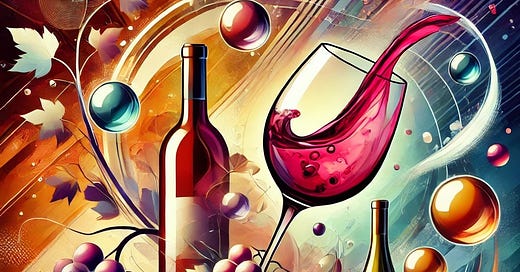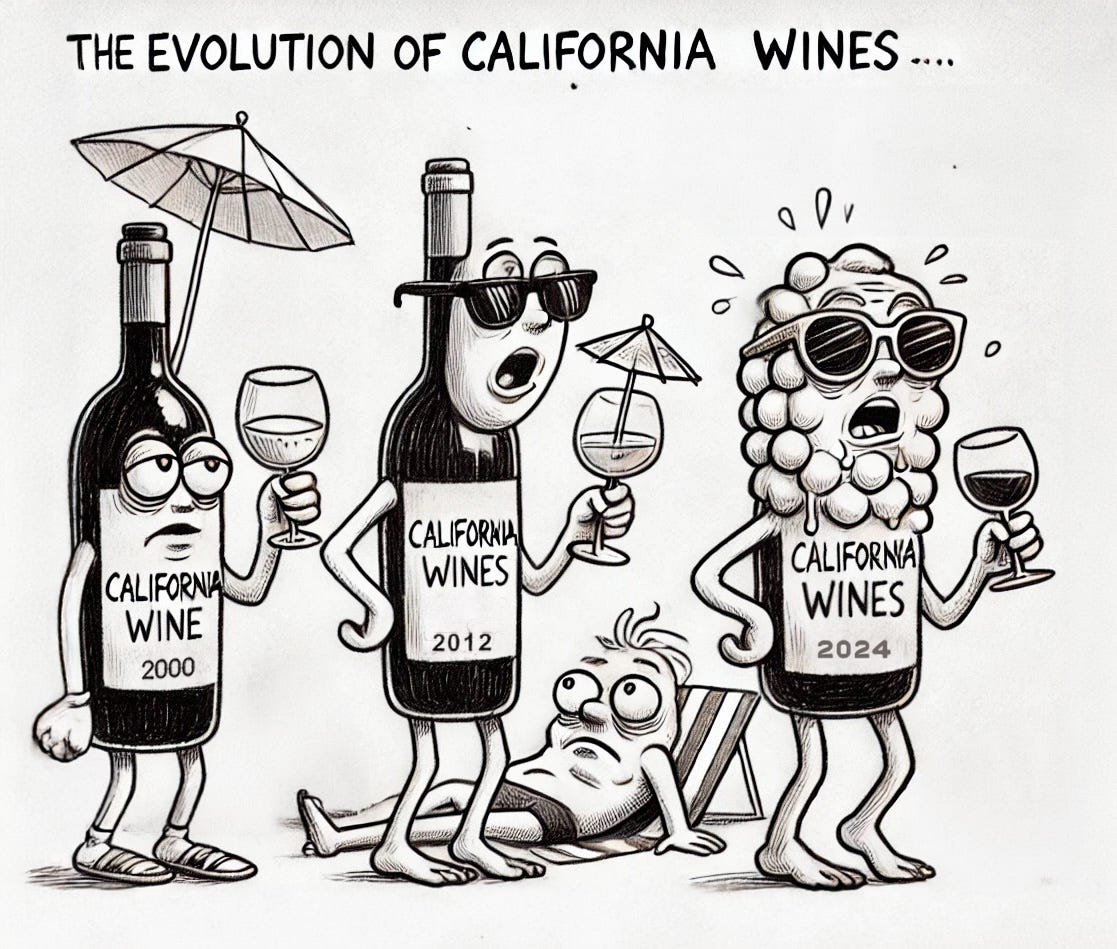NAPA VALLEY, Calif. —People who drink putatively dry California wine regularly ought to be irate that so much of it has nothing to do with the dry wines with which we grew up. Unfortunately, I don’t hear many complaints. Indeed, most of the complaints I get occur when people call me a scold for my frequent diatribes. But there is no question that wine has changed cataclysmically over the years.
In the last few decades, California’s fine wine styles have skidded inexorably toward softer, sweeter, more alcoholic oafs. I am saddened by this weakening in charm. I see most of these wines are being targeted toward amateurs. Fine wine typically is dry. And the move I’ve witnessed in the last 30 years is in the wrong direction for people who want to serve wine with food.
Key Takeaways
Changing Wine Styles: California “table” wines have become sweeter, softer and more alcoholic over the years, moving away from traditional dry styles.
Alcohol Levels: Previously, table wines had 11% to 14% alcohol. Now many wines exceed 14%, some reaching up to 17%.
Use of Sugar: Concentrates like Mega Purple add sugar and alter the wine's natural flavors, making wines sweeter and less varietal-specific.
Lower Acidity: Extended hang times for grapes lead to lower acidity, altering the wine's balance and aging potential.
Market Influence: Modern wines are tailored toward mass appeal, often at the expense of traditional quality.
Finding Quality Wines: Despite trends, California still produces excellent table wines, though finding well-balanced, dry wines can require exploration and experimentation.
This trend has been so slow that most wine buyers never noticed – or just never complained. Indeed, most wine drinkers have accepted this sad situation. Industry watchers see this as just another evolution in the industry’s inevitable quest to sell stuff to people who will drink mediocrity without any analysis or complaint — and at escalating prices.
If you want a fine wine that’s truly dry, you generally need to do some serious homework. But don’t think you can find examples of dry wines by shifting to Europe. That was one of the strategies you could have employed roughly a decade ago to find a dry wine that suits your palate. But recently even some traditional European wines are becoming a little less crisp than they were. Many are being made for people who don’t know very much about wine and do not care to learn.
This decline in the style of fine table wine in California continues apace. Here are a few of the factors we face:
Alcohol
Decades ago, grapes were harvested at lower sugar levels, which typically produced more balanced wines that were perfectly fine for pairing with food. They were called “table wines” and were defined by the U.S. government to be between 11% and 14% alcohol. And they were intended to go with food.
People didn’t typically use them as walking-around cocktails. In the 1970s almost all wines were 12% alcohol; wines with 13% were considered to be huge. Higher-alcohol wines typically are sweeter on the palate. In the early 1980s, most wines’ alcohol levels were about 12.5% to 13%.
The serious rise in alcohol levels began about 1990. But inexpensive wines stayed below 14% because no winery wanted to pay the added federal tax associated with any wine that came in at more than 14% alcohol. The over-14%-alcohol federal tax added about 10 cents to the cost of a bottle. And wineries’ profits on under-$10 wines were thin; they hated paying the added tax.
In the two warm North Coast harvests of 1994 and 1997, it was hard for winemakers to keep alcohols under 14%. However, by then prices for finer wines were rising, and the additional dime in the cost of a bottle was less of a factor. (In fact, the federal tax on wine between 14% and 16% alcohol recently was reduced.) And consumers generally liked the 1994 and 1997 Napa cabernets. No such wines were over 14%.
Today it’s hard to find many wines that are called premium (the operative word here is “called”) at less than 14%. And a lot of pricey but very ordinary (and high-scoring) wines now are close to, if not over, 15%. Several winemakers I know well tell me that many of these “15% alcohol” wines really are closer to 17%.
The U.S. government has traditionally defined the phrase “table wine” as anything from 11% to 14%. Anything over 14% was technically called dessert wine. Which leads us to the next term with which we have to deal.
Sugar
This issue didn’t become a serious factor in dry-wine production until the 1990s, when the previously scant use of concentrates exploded. When added before fermentation, concentrates (with their 66% sugar content) add alcohol to the wines but also inject a terrible aromatic “plus” that has nothing to do with the varietals we know.
Concentrates have typically been used in areas where insufficient sun or exceedingly cool temperatures do not produce grapes with enough sugar. Winemakers then can add concentrate to a fermentation, which increases s wine’s alcoholic content slightly and gives the wine a slightly richer mouthfeel.
One of these products is called Mega Purple. It typically is used in small amounts because a little goes a long way. In making a red wine, a customary concentrate addition represents only one-tenth of 1% of the final wine. To use more than that runs the risk that the aroma will change and a wine will be slightly sweet. It is also possible to add concentrate to a wine that has finished fermentation. When this is done, the result adds actual residual sugar to the final product.
A decade ago I got together with several Napa Valley winemakers and conducted tests with Mega Purple. Not only were very small amounts detectable in test wines — and most unattractive — but the wines with slightly higher levels of the concentrate were noticeably sweet and also less typical of the grape variety that had been used to make the wine.
Recently I lab-tested a particularly popular and expensive Napa Valley cabernet ($70). Not only did the wine have actual residual sugar of more than 1 percent (11.4 g/L), but the wine smelled nothing like cabernet. The aroma was basically raisin-y, and the wine was terribly unbalanced. It was sweet!
Lower Acid
Two decades ago a pernicious trend began in which wineries told growers to leave their grapes on the vine longer than the growers preferred. Wineries said they were seeking greater “physiological maturity.” But many growers said this was nothing more than a cynical ploy so wineries could pay less for their fruit. Most growers charge for grapes based on harvest weight.
By leaving grapes on the vine longer than they should be left there (called “hang time”), wineries knew that the fruit would lose water through desiccation and they would end up paying a lot less for the grapes. And wineries can later solve that problem. Once they get the extremely high-sugar-content juice into their fermentation tanks, winemakers can replace the lost liquid with water from a hose.
Inside the industry, some winemakers refer to this water addition to grape juice as adding “Jesus units.” This rehydrating of dried-out fruit allows for a red wine to be made with flavors that are similar to the grapes if they had been picked earlier. But one inevitable difference is that by harvesting late, there is less natural acidity and the wine has a latent “overripe” aromatic. And acid adjustments are entirely legal.
Leaving fruit on the vine longer than necessary can lead to wines in which basic aromatics are altered. This might not be noticeable when the wine is extremely young. But the aromatic change usually shows up as the wine ages in the bottle. Plums and prunes begin to creep into the wine not long after it begins its aging cycle. Fresh fruit disappears more quickly.
At this point in our analysis, only three things have changed since the 1980s: more alcohol (which gives the wine a slightly sweet impression in the mouth), more sugar (sweetness) and lower acid (less tartness), all of which make for wines that are softer and thus easier to sell to novices. Another factor that has been compromised has to do with the wines’ chemistry, which I won’t discuss here. But it is more important than the other three.
Each of the above factors, taken alone, would be a sea change in how wine is made in California. Taken as a group along with a few other tactics, the wines we have today are not even cousins of the wines we saw in the 1970s.
The fact is that we now are mostly technically consuming dessert wines with our dinner. Wineries tell us that these are dry wines. But one taste tells us that isn’t true. I had a bottle of an expensive ($125) Napa cabernet last week. The aroma was more prunes and raisins than grapes. The massive mouthfeel made the wine taste clumsy. (Alcohol was listed as 14.8%.)
It had no aroma that I associate with cabernet. It could have been made from any grape. It was not made to go with food. The aftertaste was chocolate-y. It might be OK with Stilton cheese after a meal, the way you would serve Port. A second sip proved even more disappointing. The wine was sweet. A final problem: It was almost cloying and so “hot” that chances are that what little acid it had did nothing to make it drinkable with savory food. And I was sure it wouldn’t age.
Adding up the changes we have seen in last three decades in California, it’s easy to see that the wines we are getting from most producers, even very expensive red wines, mainly are softer, sweeter and more alcoholic than any of the wines we saw in earlier eras.
About 2010, I heard some retailers and restaurant wine buyers suggest that this odious development was slowly reversing itself. People said that dry California wines were “lightening up” and becoming “better balanced.” They said chardonnays were becoming slightly lighter and less oaky, merlots were becoming more elegant, and cabernets were becoming less alcoholic and less oaky.
I was heartened; it was welcome news, so I began looking for examples. In the last 14 years it has been hard to find these wines. The number of people who are trying to make wines like this can be counted on one hand. And to get this kind of wine, you have to go to extreme lengths.
In the last 25 years I have heard many wine educators and writers state “wine truisms.” For the most part, this blather amounts to brainwashing about iconic wines that some people describe as dry. This drivel is intended to persuade once-novice (and still novice) wine buyers that bigger is better. This is a message that continues to show support among those who still quote numbers as indicators of quality.
Buying into this message of support for cult wines is equivalent to drinking Kool-Aid, although the product won’t kill you. A good friend once wanted nothing but hundred-point wines. He bought all he could buy. About 2012 he decided to do a tasting of 17 of these. Midway through the event, a winemaker who was invited to this extravaganza asked if the host had brought anything we could actually drink that evening.
My friend has since switched allegiances. He now buys wines from the 1970s, which he calls “treasures.”
Some people ask me if I still drink today’s California wine. Of course I do. This state continues to make some of the greatest wines anywhere; they just need to be carefully selected. This state grows some of the greatest grapes in the world, and we have some of the finest winemaking techniques and the most talented winemakers. California is still a blessed location to make sensational wines, and the aromas and flavors can be truly unmatched.
The preceding diatribe aside, I am still committed to California as a phenomenal place to grow grapes and make great wine. After 50 years of writing about it, I still get excited when I find someone who has decided to make a real statement — of varietal character, of sub-regional identity, of balance, of personality. Someone who is committed to the soil and to the legacy of style and who continues to live vibrantly by adhering to authenticity.
But it is becoming far more difficult for me to find these dependable wines that are available for my readers. Sometimes the wines I like most are produced in such tiny amounts that I can’t in good conscience write about them. Occasionally a wine comes along that is so outstanding that I wish I could write about it except that it is too expensive for most readers or is in limited supply. And then there are those wines that I adore that are made to improve in the bottle so long that they require decades. Again, they are not great candidates for me to write about.
What bothers me most is the preponderance of wines that are called succulent, delicious, tasty, luscious, scrumptious and juicy. Yes, such wines can have their place in the market. I love some of them. But not every day. Not in table wine. And not when they are supposed to be dry but are not.
When I seek a crisp sauvignon blanc to go with a specific food, words like the above have no place describing a wine for my dinner table. I want a sauvignon blanc that has the balance and acid structure to pair with halibut or sole, not Jolly Rancher gummies. ”Dry” wines being described as “delicious”? No, thanks.
When a wine is being specifically targeted toward the masses of consumers who put six pumps of hazelnut syrup into their lattes, it’s likely that that wine isn’t one I’d rush to buy. Even if a wine critic calls it tasty.
Berger’s Wine Discovery of the Week
2023 Massican Gemina Sauvignon Blanc, California ($32) – It is extremely rare to find a sauvignon blanc that carries with it such distinctive varietal notes of lemongrass, lime, kiwifruit, and traces of tarragon and lemon zest. Here the grape is displayed with a surprisingly interesting richness in the entry but terrific, bracing acidity in the finish. With less than 13% alcohol, it clearly is designed to go with food. But it also has the physical structure to improve with time in the bottle — though it is so delicious now, I cannot imagine waiting. From the winery’s website: “Inspired by the Sauvignons of northern Italy, ours pays homage to the tart and delicious everyday workhorse of the region of Friului. … [It is] our interpretation of these great Italian white wines. The grapes are harvested from distinct vineyards in Napa and Sonoma where the temperatures are warmest during the day and coolest at night.” It is perfectly balanced. Bottle Barn in Santa Rosa has this wine for $26.99.
If today’s story captured your interest, explore these related articles:
Dan Berger’s Wine Chronicles: The Nostalgia and Nonsense of Barrel Tastings
Dan Berger’s Wine Chronicles: The Evolution and Art of Winemaking
Dan Berger’s Wine Chronicles: How Wine Is Packaged Can Affect Its Quality
Dan Berger's Wine Chronicles: Aged Red Wines Are Still 'Fine'
Wine in Crisis: Navigating Prohibitionist Waves and Market Shifts
Dan Berger's wine chronicles: The evolution of wine in a warming world
Dan Berger has been writing about wine since 1975.









This is the ongoing loss of style and sense of place in wines, with some elegance and complexity, initiated by Robert Parker giving high scores to high-alcohol, tannic, fruit bombs with no sense of place. Many in the industry changed their traditional wine-making practices to chase high scores. This trickled down to table wines. Sad to watch evolve.
As someone who has been in the industry since the 1970's, I love to read Dan's comments. I wish he named more names about the wines he appreciates.